Longing for Linsangs
Posted by: Loren Coleman on June 24th, 2008
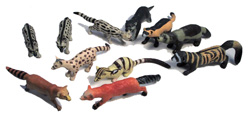
What is one of the world’s rarest carnivores? It’s the linsang.
But what’s a linsang? Of the figurine collection above, can you pick out the linsang? (The answer is below, as I share images of almost a dozen of these animal replicas for this discussion, in the last third of this posting.)
During my trek in pursuit of replicas of the most unusual cryptids and animals, I made an amazing discovery of this scarce animal and its kin modeled as hand-painted small figurines. How is it that an animal so near extinction but unknown generally would have a replica made of itself?
Cryptid Trailcam Viverrids
One immediate link to cryptozoology, regarding these animals, is that they are exactly the kinds of species that are turning up in trailcam photos from unexplored rainforests of the world, often with little background info for Western eyes.

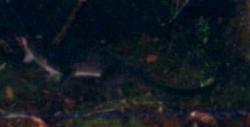
Photo credit: Wildlife Conservation Society, Upper Baram Project, Malaysia.
A series of camera trap photos taken in 2004, on the unlogged areas of Mount Murud Kecil, Sarawak, revealed this slender unknown civet, shown above, with a very long tail, pale underparts and white around the muzzle. It appeared to be similar to Hose’s palm civet (Diplogale hosei). Hose’s palm civet is known from only 15 museum specimens, the last of which was collected in 1955. This photographed animal was seen in an area that is not known to be the normal habitat of the Hose’s palm civet. Was it a new yet-to-be-classified civet or a demonstration of a more widespread distribution of the Hose’s palm civet?
It is about time we study a bit more deeply the viverrids (linsangs, civets, genets, binturongs), and the closely aligned non-viverrids, the mongooses. (Interestingly, that latter group has gotten a good deal of attention, for some specific mongooses have a user-friendly name and live in social humanlike colonies – the meerkats.)
The viverrid group is so ancestral, it contains an animal model that we’ve seen often.
As observed in The Kingdon Field Guide to African Mammals (London: Academic Press Ltd., 1997: 267):
“Genets bear an extraordinary resemblance to the totally unrelated spotted marsupial, Dasyurus and to the cacomistle, Bassariscus (a raccoon). They resemble the Madagascan Fossa and Oriental linsang, Priondodon, in spite of their common ancestry being more than 20 million years old. This suggests that the requirements for success in the arboreal niche is exacting for small carnivores as it is for some primates (which are also convergent on different continents).”
In contrast to the genets that are arboreal, nocturnal viverrids, mongooses are more commonly terrestrial and many are active during the day. The civets, like the mongooses, are terrestrial. Linsangs, all three species, are nocturnal and arboreal. The binturong (Arctictis binturong) is likewise arboreal, nocturnal, and is one of only two carnivores with a prehensile tail (the procyonid kinkajou is the other).
The African civets have fixed nonretractible claws in doglike pads. Other civets and genets have retractible claws and, according to some scholars, appear to be the precursors of cats. The Asian linsangs have retractile claws, while the African linsangs have semi-retractile claws.
These animals are a pondering delight. No wonder that some of the arboreal cryptids out there might be viverrids.
Linsangs
For me, I began my indepth search, with the little-known linsang, as a gateway species to my understanding of the supposed viverrids ~ cryptids and otherwise.
In terms of an inside joke here at Cryptomundo, the name linsang is from the Javanese linsang or wlinsang, which used to be wrongly translated as “otter” in English dictionaries.

The spotted linsang (Prionodon pardicolor), above, is presently represented by only about 200 individuals, making it perhaps the globe’s most endangered Carnivora species.
Linsangs are nocturnal, generally solitary tree dwellers. They eat squirrels and other rodents, small birds, lizards and insects. Typical size is a little over 1 foot (30cm), with a tail that more than doubles that length. Bodies are long, with short legs, giving a low appearance (like an otter, of course). All species have yellowish bodies with black markings (stripes, blotches and spots), though the distribution and nature of the markings varies between species.
The Asiatic linsangs are two species classified in the mammalian subfamily Prionodontinae, in the family Viverridae. There is one Southeast Asian genus, Prionodon. The species of Asiatic linsang, specifically, are: Prionodon linsang – The Banded Linsang – and Prionodon pardicolor – The Spotted Linsang.
Both linsang genera (Prionodon and the African Poiana) formerly were placed in the subfamily Viverrinae (of Viverridae), along with several other genera, but recent research suggests that their actual relationships may be somewhat different. The linsangs are remarkable for their morphological resemblance to cats, family Felidae, which is greater than in the other viverrids.
As the relationship between linsangs and cats was thought to be rather distant (the two groups belonging to different families within the superfamily Feliformia), this was considered an example of convergent evolution. However, DNA analysis indicates that while the African linsangs (Poiana) are true viverrids closely related to the genets, the Asiatic linsangs (Prionodon) are not and may instead be the closest living relatives of the Felidae family. The similarities between Asiatic linsangs and cats are thus more likely to be due to common ancestry, while the similarities between the two genera of linsangs appear to be purely due to convergence.
As implied above, a recent molecular and morphological analysis indicates that the genus Prionodon should probably be placed within its own family Prionodontidae (Gaubert et al. 2005).
The Replicas
Who could have ever guessed that I would be able to find a replica of this animal? But I did. It doesn’t equal my joy of perhaps one day finding a living Bigfoot, but, I must say, it was an emotional find, nevertheless.
The pot of gold at the end of the rainbow happened to be the Tapir Preservation Fund where I discovered the linsang figurine.
There, among more tapir models than I’ve ever seen before in my life, I found several other quite attractive, rarely-seen, hand-painted civet, genet, and mongoose replicas. Here are snapshots of some of them:
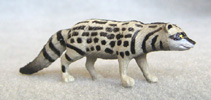
The African civet (Civettictis civetta).

The banded palm civet (Hemigalus derbyanus).
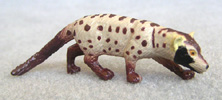
The common palm civet (Paradoxurus hermaphroditus).
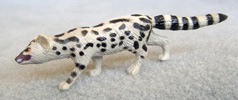
The Abyssinian genet (Genetta abyssinica).
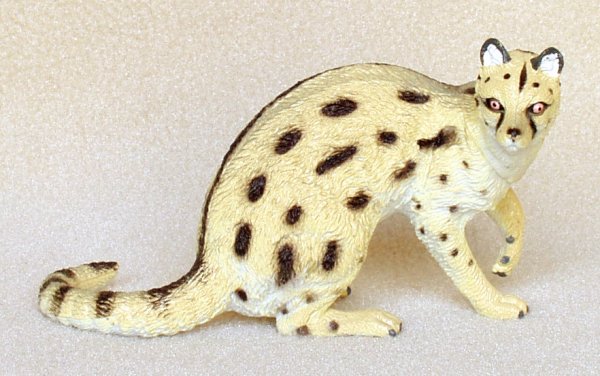
The small spotted genet (Genetta genetta), also known as the common genet or European genet. (These look like a beautiful pet, but I bet they are hard to tame.)

The aquatic genet (Genetta piscivora).
And the close relatives of the viverrids, members of the family Herpestidae….the mongooses:
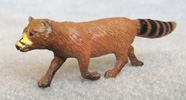
The ring-tailed mongoose (Galidia elegans). Lest we forget, the American procyonids ~ the raccoons, coatmundis and kinkajous ~ look like some of these mongooses because of convergent evolution.
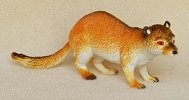
The yellow mongoose (Cynictis penicillata), a.k.a. the red meerkat.

The small Asian mongoose (Herpestes javanicus), also known as the Indian mongoose, small Indian mongoose, or the Javan mongoose, which is not to be confused with the Indian brown mongoose (Herpestes fuscus).
Exhibition Worthy
My special tribute for the day goes to probably an unnamed Asian artist/toy manufacturer who came up with the idea of making a nearly 3 inch (8 mm) long figurine of the linsang, now a prized possession in my animal replica exhibitions. (I’ll have to remind Darren Naish to obtain one for his vast UK-based mammalian replica collection.)

The spotted linsang (Prionodon pardicolor).
^^^^^^^^^^^^^^^^^^^^^^^^^^^^^^^^^^^
The Source
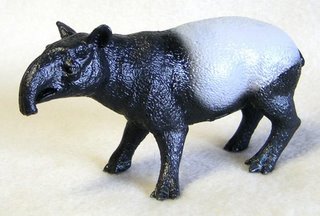
I have a little bit more to share about where I found today’s featured replica. By chance, I stumbled across a small outfit out in Oregon, the Tapir Preservation Fund, a member of the IUCN/SSC Tapir Specialist Group. As a way to support their tapir efforts, they run a gift store, which has some of the most unique animal figurines I’ve ever seen gathered in one place.
I suggest, if even mildly interested, you journey there (click here) and take a look. I’m going to be highlighting other cryptic animal replicas I found through them, in the near future, but, for now, enjoy a peek. Remember, you’ll be supporting a good cause, if you buy any of what they offer.
My thanks to Sheryl Todd, President of the Tapir Preservation Fund, for her permission to use her site’s photographs of the above figurines/replicas on Cryptomundo.
About Loren Coleman
Loren Coleman is one of the world’s leading cryptozoologists, some say “the” leading living cryptozoologist. Certainly, he is acknowledged as the current living American researcher and writer who has most popularized cryptozoology in the late 20th and early 21st centuries.
Starting his fieldwork and investigations in 1960, after traveling and trekking extensively in pursuit of cryptozoological mysteries, Coleman began writing to share his experiences in 1969. An honorary member of Ivan T. Sanderson’s Society for the Investigation of the Unexplained in the 1970s, Coleman has been bestowed with similar honorary memberships of the North Idaho College Cryptozoology Club in 1983, and in subsequent years, that of the British Columbia Scientific Cryptozoology Club, CryptoSafari International, and other international organizations. He was also a Life Member and Benefactor of the International Society of Cryptozoology (now-defunct).
Loren Coleman’s daily blog, as a member of the Cryptomundo Team, served as an ongoing avenue of communication for the ever-growing body of cryptozoo news from 2005 through 2013. He returned as an infrequent contributor beginning Halloween week of 2015.
Coleman is the founder in 2003, and current director of the International Cryptozoology Museum in Portland, Maine.










Viverrids, “toys”, and tapirs in one posting may be too much charm for my pea-sized brain to handle!
I happen to be a huge binturong fan as I met one at a Renaissance festival back in high school and I thought it was the most amazing animal I had ever encountered. I had to ask his keeper twice what he was; and then I promptly spent the next six months researching everything I could about it.
Yeah, I’m older than the internet…
Actually genets have been tamed for centuries in northern Africa and southern Europe (the Mediterranean area). They have been used as mousers and pets – much the same as cats, and possibly even earlier than cats were tamed. They get to be about as tame as cats, but there must be something that has prevented them becoming as popular as cats. They’ve never been selectively bred the way that cats have (to my knowledge), but in many parts of their native ranges, small viverrids such as genets are still kept as semi-tame pets and mousers.
Genets and linsangs, especially, are very catlike – right down to their tabby coloring, which in some species is identical to the colors that, in domestic cats, are known as brown tabbies. As you know, Loren, from your experience with Maine Coon Cats, brown tabby is actually an agouti color which appears mostly as gray due to the bands of color on individual hairs. European genets also purr like cats, and they have retractable claws. They eat more insects as opposed to rodents and birds than cats do, and that fact is reflected in the structure of their face. Basically, they look like a tabby cat made of taffy that someone grabbed by each end and stretched.
Cats, genets, linsangs, and fossas are all closely related, and that group is a bit more distantly related to civets and then to mongooses, with the whole lot then again related to hyenas (probably through the civets).
The smaller mustelids, procyonids, herpestrids, and viverrids share similar body types and probably similar lifestyles to the miacids, from which they are descended and which were the ancestors of the carnivore order as a whole. They are all fascinating animals!
The living cryptoprotids (fossas) are very, very close in body type to the first animals that can be called cats and there is still debate over whether to place them within the Felidae. Fittingly, in my opinion, they are now considered to be an ancient family of one species, closely related to both felids and viverrids.
I love viverrids! They are such beautiful little creatures and not much is known about them. There are probably many species still to be discovered; hopefully they will be recognized in time to prevent their extinction from habitat loss.
Thanks Loren, for this terrific post!
That is a terrific site for plastic animal models. Thanks for pointing it out, Loren.
I tried to assemble a complete collection of bear models lately.
I am at a loss to know why no one makes a giant short-faced bear, as spectacular a critter as Arctodus simas was. For that matter, I can’t find any of the smaller modern bears, either – it’s easy enough to find polar, brown, American black, and panda bears, but no sun bears, no spectacled bears, etc. And someone should make a model of the golden moon bear phase of the Asiatic black bear.
Has anyone found any of these missing bears in the smaller (under $10 US) high-quality plastic varieties? I’ve searched pretty extensively.
Wonderful information on the Linsangs and other civets, Loren! I have been interested in civets for about 14 years when as I was mowing a hay field, two ringtails ran across the mowed area. When I saw them that day I first thought they were some genetic anomaly of a raccoon, but as I saw more and more of them and finally examined one dead in the road near my farm, I am 99% sure it was Bassariscus astutus. How they got to mid-western South Carolina is only a guess, but I think that they were brought in here as pets by Mexican immigrant workers although I cannot prove this. Anyway, an animal that loves to eat rats and mice is OK in my book!
Matt is correct. The rarer animal replicas are difficult to obtain and those, obviously, may actually be more linked to our cryptid interests.
Among the bears, for example, the Ice Age (Pleistocene) cave bear (Ursus spelaeus) is made in a museum-quality replica by several companies, including the readily available Schleich, 16521.
There is one model of Arctodus simas that I know of, but it is actually a resin piece of art, costing closer to $100, versus $5 for the plastic replicas.
Seems like I saw a plastic model of Arctodus at the Florida Museum of Natural History gift shop. I may be wrong but I think they had them.
Loren, great post! I’m currently debating whether to order a half dozen plastic replicas from them! Kittenz, thanks for the extra info! I have heard that ferrets have been domesticated at least as long as cats have, and I find this all quite fascinating. Speaking of Hyenas, I have seen wrangling over the years about how to classify them (canid, felid, canid/felid leaning one way or the other, etc). What is the current thought on that?
I guess maybe I was wrong. I’ve searched and searched and have not found an Arctodus anywhere online. maybe it was a replica Cave Bear that I saw.
We must have a spectacled bear because of Paddington…
…I was always told there are no bears in Darkest Peru, but….
(Anyhow, not all spectacled bears wear glasses…)
Hyenas are in their own family Hyenidae which usually is considered to be fairly closely related to the civets. Most place them closer to cats than to dogs. My opinion is that they are pretty distant from either canids or felids, but since they are likely descended from animals much like civets, they’re probably more closely related to cats.
For those in search of replicas of the animals mentioned in recent comments, take a look at these:
Really excellent post. Thanks for the info and links!
Great article on civets and linsangs.
Great post as always, Kittenz.
That is very interesting what you wrote, NightFlight. It is unusual, to say the least, how “Bassariscus astutus” got to that part of the country.
Wonderful!
Is any attempt being made to breed them in captivity (the extremely rare ones?)
Do they have ‘scent’ glands the way civets do? (That would explain the lack of popularity)
Genets – African and European – are bred as pets; you can buy them from several people on the internet.
I have seen a Genet for sale at a pet shop a few years ago. It didn’t strike me as something that would make a very good pet, but according to Kittenz they can be tamed, so maybe I’m wrong. I’m not sure which species it was, but it was a very beautiful animal with a pattern almost identical to an ocelot.